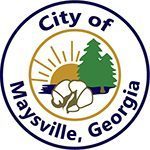City of Maysville Water System
2021 Water-Quality Report
Water System ID CG0110001
The City of Maysville Water System is pleased to present a summary of the quality of water provided to you during the past year. The Safe Drinking Water Act (SDWA) requires that utilities issue an annual “Consumer Confidence” report to customers. This report details where our water comes from, what it contains, and the risks our water testing and treatment are designed to prevent. The City of Maysville Water System is committed to providing you with the safest and most reliable water supply. Informed consumers are our best allies in maintaining safe drinking water. We encourage public interest and participation in our community’s decisions affecting our drinking water. Regularly scheduled council meetings are held on the 1st Monday of each month at 7:00 p.m. at Maysville City Hall. Comments are welcomed; please contact us at The City of Maysville – P.O. Box 86 – Maysville, GA 30558 or (706) 652-3310.
Water Source
The City of Maysville water system is supplied by ground water from one city well, source #102. Water is also purchased from the City of Commerce Water System which utilizes surface water from the Grove Creek watershed. In addition, the City of Maysville also has emergency service connections to Banks County Water System which obtains water from the Mountain Creek Reservoir.
The City of Maysville completed a well head protection plan in 2008. The plan showed there were no potential pollution sources in the control zone for source #102; copies of this plan are available at City Hall.
How to Read This Table
The chart in this report provides representative analytical results of water samples, collected in 2021 from the City of Maysville water system and the City of Commerce water system unless noted otherwise. Please note the following definitions:
Maximum Contaminant Level or MCL: The highest level of a contaminant that is allowed in drinking water. MCLs are set as close to the MCLGs as feasible using the best available treatment technology.
Maximum Contaminant Level Goal or MCLG: The level of a contaminant in drinking water below, which there is no known or expected risk to health. MCLGs allow for a margin of safety.
Maximum Residual Disinfectant Level of MRDL: The highest level of a disinfectant allowed in drinking water. There is convincing evidence that addition of a disinfectant is necessary for control of microbial contaminants.
Maximum Residual Disinfectant Level Goal of MCRDLG: The level of a drinking water disinfectant below which there is no known or expceted risk to health. MRDLGs do not reflect the benefits of the use of disinfectants to control microbial contaminants.
Regulatory Action Level: The concentration of a contaminant, which triggers treatment or other requirement, which a water system must follow.
Volatile Organic Contaminant Date Units MCL MCLG Detected (Highest) Range Major Sources Violation?
Total Trihalomethane,TTHM By-product of drinking water disinfection
City of Maysville Quarterly ppb 80 n/a 70.9 9.7-133.3 NO
City of Commerce Quarterly ppb 80 n/a 67.17 38.4-124.0 NO
Haloacetic Acid, HAA5 By-product of drinking water disinfection
City of Maysville Quarterly ppb 60 n/a 65.8 15.3-77.9 YES
City of Commerce Quarterly ppb 60 n/a 46.93 29.6-63.7
Chlorine Residual Water disinfectant
City of Maysville Monthly ppm MRDL =4 MRDLG =4 1.17 0.88-1.57 NO
City of Commerce Monthly ppm MRDL =4 MRDLG =4 0.99 0.30-1.77 NO
Total Organic Carbon Naturally present in the environment
City of Commerce Monthly Ratio N/A TT
